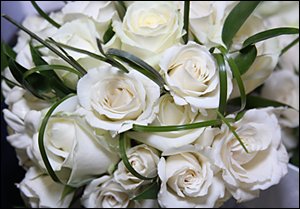 The Royal wedding of Prince William and Kate Middleton highlighted an often forgotten Victorian tradition where people used flowers to express their feelings. This practice goes under the name of floriography and when Kate Middleton chose the icing designs for the wedding cake her choice of flowers was crucial.
The Royal wedding of Prince William and Kate Middleton highlighted an often forgotten Victorian tradition where people used flowers to express their feelings. This practice goes under the name of floriography and when Kate Middleton chose the icing designs for the wedding cake her choice of flowers was crucial.
These are the flowers she chose:
White rose, daffodil, shamrock and thistle for the England, Wales, Ireland and Scotland.
Strength and endurance were symbolized by acorns and an oak leaf.
Love came with myrtle and Ivy said that this was wedded love.
Lily of the valley combined with a bridal rose showed Kate as sweetness and humility combined with happiness.
She asked for a smile by including Sweet William and rounded it off with Honey suckle and Apple blossom which are used for the bond of love and good fortune.
Let’s look at the old traditions and how and why they were used:
The love of flowers was introduced to Western Europe by the Ottoman Turks. The crusades of the medieval ages were the catalyst to start the flow of eastern traditions and culture from the Middle East into Western Europe. This was given an added impetus when Mehmed II captured Constantinople in 1453.The flower most commonly associated with the Ottoman empire was the Tulip which is believed to have originated in the Pamir mountain range of central Asia.
The first mention of floral symbols in England was during the reign of Queen Elizabeth I. But Lady Mary Montagu, the wife of the ambassador to the Ottoman court, then mentioned the customs of symbolism and flowers back in 1718. However it wasn’t until 1763 that this was first explained in detail when she published her Turkish letters.
As Victorian society became more restrictive it was difficult to say what you really thought without running the risk of violating the strict social codes of those days. To help alleviate this people turned to flowers to say what they felt. However this was a complex way to communicate as the same flower held different meanings. Also the way they were presented and even the hand which held them could all tell a message.
The ideal was for both parties to use the same floral dictionary to avoid the problems written about by Louisa Anne Twamley. Her poem “Carnations and Cavaliers” spoke of a gentleman sending his lover a pink rose which symbolized love and perfect happiness. However not understanding the symbolism she replied with a carnation for refusal. Tragedy followed with each died of unrequited love.
During the Victorian era the use of Tussie Mussies or Nosegays became popular. These could be worn to provide strong scents to ward off some of the less pleasant smells of those days. However the choice of flowers also carried a hidden message.
Surprisingly the language of flowers also allows you to insult someone. For instance the hydrangea normally means heartlessness or possibly frigidity. Nuts imply stupidity and the amaranthus flowers talks about desertion.
So the next time you step into a florist lets imagine each flower talking to you about passions and love.
About the author: This article was written by Mike Holly who has been searching for wild flowers around Hexham in Northumberland.
Credits: Photo courtesy of Colin Hughes.